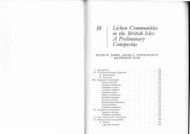You also want an ePaper? Increase the reach of your titles
YUMPU automatically turns print PDFs into web optimized ePapers that Google loves.
Psoretum – s’mieur-med – v.rare (1); Mn<br />
(Taubertal), FrJu, Do, Av<br />
Catapyrenium waltheri (Krempelh.) Körber<br />
(Dermatocarpon w. (Krempelh.) Blomb. &<br />
Forss.)<br />
In alpine sites on naked soil and raw humus over<br />
calcareous subsoil – arct-alp – v.rare; Al;<br />
scattered in the Alps<br />
LIT: BREUSS 1990<br />
Catillaria Massal.<br />
(Keys include Catinaria, Cliostomum, Megalaria,<br />
Micarea p.p.)<br />
Introduction<br />
In the broad sense one places in Catillaria<br />
crustose lichens with two-celled colorless spores<br />
and various colored apothecia without thalloid<br />
margins. Catinaria, Cliostomum, Megalospora<br />
and Micarea were separated from this unnatural<br />
group genus according to various characteristics<br />
in the construction <strong>of</strong> the apothecium. Catillaria<br />
in the narrow sense includes species with<br />
generally thin, gray to nearly indistinguishable<br />
thalli living in the interior <strong>of</strong> the substrate,<br />
usually black to brown-black apothecia with<br />
lecideine proper margin, paraphyses unbranched<br />
to singly branched in the upper part with capitate<br />
thickened, provided with a brown apex capped<br />
ends and two-celled elongate spores.<br />
C. atomarioides and C. chalybeia occur on<br />
(mostly mineral rich) silicate rock; C.<br />
lenticularia lives on calcareous rocks and C.<br />
nigroclavata on bark. C. chalybeia frequently<br />
invades man made substrates. The indigenous<br />
rock dwellers are distributed in the south and<br />
central Europe and penetrate above all in the<br />
west widely into the boreal zone. C.<br />
nigroclavata occurs up into central<br />
Fennoscandia.<br />
C. detractula, C. erysiboides, C. minuta and C.<br />
picila do not belong to Catillaria s.str. The latter<br />
two live on shaded limestone on vertical and<br />
overhanging surfaces on humid habitats. C.<br />
detractula is found on well lighted, warm sites on<br />
limestone, C. erysiboides on tough old wood, e.g.<br />
deciduous tree stumps. C. erysiboides is<br />
distributed in the boreal and summer green<br />
deciduous region. The area <strong>of</strong> C. alba, C.<br />
anomaloides, C. detractula, C. picila and C.<br />
minuta stretches over south and (predominantly<br />
to the south) central Europe; finally an<br />
occurrence (Gotland) in south Scandinavia.<br />
Genus Characteristics and Determination<br />
Thallus crustose, clearly developed to living in<br />
the substrate, whitish, gray, brown, blackish, with<br />
various coccoid and filamentous green algae.<br />
Ap. variously colored (in Catillaria i.e.s. black to<br />
dark brown), without thalloid margin, with or<br />
rarely without definite proper margin. Exc.<br />
usually clearly developed. Paraphyses simple to<br />
sparsely branched, capitate above, with brown<br />
cap (Catillaria i.e.s.) or colorless to pigmented<br />
above. Hyp. colorless to brown-black. Asci<br />
almost cylindric to clavate, in the case <strong>of</strong><br />
Catillaria i.e.s. with uniformly I+ (K/I+) blue<br />
tholus and exterior with thin I+ (K/I+) blue<br />
gelatin layer, in the case <strong>of</strong> Catillaria i.w.s. to the<br />
part Biatora- and Bacidia- type. Sp. 2-celled.<br />
Ch-.<br />
1 On garden soil, humus, plant detritus, moss . 2<br />
1* On rock, bark, wood, living on conifer needles . 6<br />
2 On naked mineralized, sandy-loam to loamy<br />
soils. Ap. convex to hemispherical, marginless,<br />
black, -0.6 mm. Epihym. and hyp. dark purplebrown,<br />
hym. purple. Exc. dark purple, soon<br />
reduced. Sp. 1-2 celled, 9-15 x 3-4(4.5) µm.<br />
Paraph. branched in the upper part. Thallus very<br />
thin flowing, scattered or warty areolate, blue<br />
greenish. Saxony .<br />
Micarea melaenida (Nyl.) Coppins<br />
2* On mosses, plant detritus, raw humus, humus<br />
soils 3<br />
3 Hyp. light, mostly colorless. Ap. whitish,<br />
yellowish, rose, brown, discolored gray 4<br />
3* Hyp. red-brown to black-brown 5<br />
4 Sp. 10-17 x 4-5 µm, with definite epispore, 2- to<br />
rarely 4-celled. Ap. brown-rose, orange, roseyellowish,<br />
yellowish, beige, convex from the<br />
first, -0.9(1.1) mm, sometimes coalescing, margin<br />
rapidly disappearing. Epihym., hym., hyp. and<br />
exc. colorless to slightly yellowish, exc. strongly<br />
developed, paraplectenchymatous. Paraph.<br />
scarcely branched, strongly cemented, 3-4 µm.<br />
Thallus greenish-gray, thickly fine granular to<br />
erupting sorediate, the sorediate region greenish,<br />
soredia 30-70 µm. Zeorine . .<br />
Mycobilimbia sphaeroides<br />
4* Sp. smaller. Ap. convex. Paraph. branched and<br />
reticulate. Exc. mostly strongly reduced, paraph.<br />
hyphae like ↑ Micarea<br />
145





